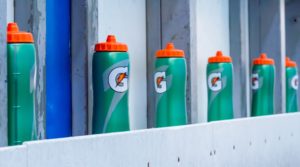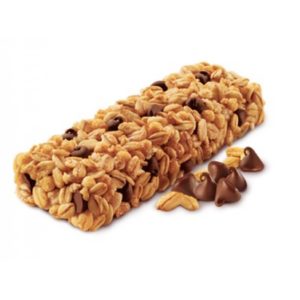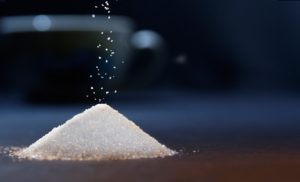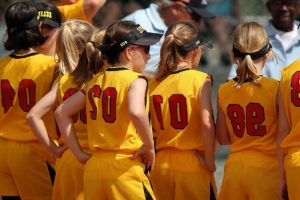An interview with Dr. Chris Mohr, RD

As parents of a child that loves to be involved with sports, my wife and I find ourselves with a million questions in regards to how to make sure our daughter is getting the right type and amount of quality nutrition. Obviously, our motivations go well beyond the goals of sports performance.
Like any parent, we want to help create positive relationships and habits with food that will last for life.
My go-to resource for everything nutrition is my good friend and colleague, Dr. Chris Mohr. Dr. Mohr is a nationally renowned author and registered dietician. He consults with celebrities, high profile corporate executives, professional athletes and teams, fortune 100 companies, and moms and dads just like “the rest of us” on how to make quality nutrition an attainable part of life.
I had an opportunity to sit down with Chris recently with some of my questions. As usual, he offered up some valuable nutritional nuggets for parents of young athletes.
If my young athlete has a game tomorrow, is it necessary to carbo-load the night before?
 This is a really common question because it’s sort of been engrained into athletic tradition over the years. Carbo-loading for children the night before an activity doesn’t provide any advantages as long as they are eating a diet balanced in carbohydrates, proteins, and fats. There is a strategic process for adults to make sure their glycogen stores are optimized but a young athlete’s physiology doesn’t merit this.
This is a really common question because it’s sort of been engrained into athletic tradition over the years. Carbo-loading for children the night before an activity doesn’t provide any advantages as long as they are eating a diet balanced in carbohydrates, proteins, and fats. There is a strategic process for adults to make sure their glycogen stores are optimized but a young athlete’s physiology doesn’t merit this.
That being said, many of us can remember pasta dinners the night before a big tournament or game. While these types of traditions may not provide a physiological benefit to young athletes, the social team building aspect could be important.
The evening before an athletic event, just see to it your athlete has options for carbohydrates, proteins, fruits and vegetables, and healthy fats.
So now it’s game day. What are the best types of foods to have right before they play?
There’s a few things to consider here. How soon will they be performing after they eat? In order for food to be used for energy, it has to be digested. If they eat in the morning and have an afternoon game, a breakfast balanced with a source of protein, complex carbohydrate, and fruit/vegetable is a great option. Combining the protein with the carbohydrate helps slow the release of energy, making it last longer. Pancakes and eggs, an egg sandwich, and Greek yogurt with berries/granola are all great examples of ways to combine foods for good nutrition.

If they’re eating close to an event, consider how long it’s been since they ate last. Most of the time, you just need to “top off the tank”. This might be something light and easily digested. It may even be something like a sports drink.
Consider the intensity and duration of the activity. My daughters are 8 and 10 years old. When they play a sport, it’s generally for under 60 minutes and they try hard, but they’re not laying it on the line the entire time. They don’t really need anything special, they just need quality energy in their system.
How about good nutrition during a sport or athletic event?
While kids are on the sidelines or during halftime, the most critical aspect of nutrition is to keep them hydrated. Make a lot of water and sports drinks available. If the activity is longer than an hour, getting more carbohydrates into the system becomes more important.
 During an activity is actually a situation where simpler, more easily digestible carbohydrates are an advantage. In the midst of kids being highly active during competition, foods that are high in fiber can load up their gut. The classic orange slices work well, but the formulation of most sports drinks make them pretty effective for providing energy during long activities. Super sweet beverages like some juices and sodas are actually too sweet and can provide too much sugar. This makes the energy from these harder to use.
During an activity is actually a situation where simpler, more easily digestible carbohydrates are an advantage. In the midst of kids being highly active during competition, foods that are high in fiber can load up their gut. The classic orange slices work well, but the formulation of most sports drinks make them pretty effective for providing energy during long activities. Super sweet beverages like some juices and sodas are actually too sweet and can provide too much sugar. This makes the energy from these harder to use.
The general rule of thumb is that hydration is the #1 concern when exercising under 60 minutes, and hydration in addition to carbohydrate consumption along with replenishing electrolytes lost in sweat becomes important when exercising for longer than 60 minutes. It’s important to understand how intensely your child is working too. If they are standing out on a field with very little movement, they probably don’t need extra carbohydrates to perform.
Despite somewhat of a bad rap for kids, it sounds like sports drinks are OK if they’re being used for what they are intended to be used for. I know that coconut water is considered by many to be a more “natural” form of sports drink that delivers hydration and electrolytes. Is one better than the other for kids?
Coconut water is great. It definitely is more natural. It’s lower in carbohydrates and sugar, but remember that these may be needed depending on how hard and how long the young athlete is exercising.
 Sports drinks do have a strategic balance of carbohydrates and electrolytes that could be important in some situations. For example, the number 1 electrolyte lost during exercise is sodium. Coconut water is actually pretty low in sodium and high in potassium. Depending on the situation, coconut water may not provide enough sodium replacement during an activity if it’s done at a high intensity for a long time, particularly in the heat.
Sports drinks do have a strategic balance of carbohydrates and electrolytes that could be important in some situations. For example, the number 1 electrolyte lost during exercise is sodium. Coconut water is actually pretty low in sodium and high in potassium. Depending on the situation, coconut water may not provide enough sodium replacement during an activity if it’s done at a high intensity for a long time, particularly in the heat.
How about strategic nutrition after a game or athletic event?
 Again, for young children, think a balance of carbohydrate, protein, and healthy fats. The carbohydrate replenishes their immediate energy stores and the protein helps the repair process. Snacks like chocolate milk, nut butter and banana/jelly/honey sandwiches, and yogurt with berries are great after-sport options that kids will eat.
Again, for young children, think a balance of carbohydrate, protein, and healthy fats. The carbohydrate replenishes their immediate energy stores and the protein helps the repair process. Snacks like chocolate milk, nut butter and banana/jelly/honey sandwiches, and yogurt with berries are great after-sport options that kids will eat.
When you’re a busy parent, convenience does play a large role. All of the above are transportable and provide great after game nutrition.
What type of specific foods would you recommend be part of a young athletes’ daily diet? In other words, what should be on every parents’ youth athlete shopping list?
I highly recommend making fruits and vegetables a central part of a young athlete’s diet. Not just for sports, but in order to form good nutrition habits for the rest of their life. Figure out which ones they like. Actually have them pick them out at the store. This puts them in charge and gives them some autonomy.
 Where this plan goes sideways sometimes though is when we as parents bring these great nutrition choices home but just hide them away in the refrigerator. Taking the step to actually prep the fruits and vegetables when you get home from the store increases the likelihood kids will eat them.
Where this plan goes sideways sometimes though is when we as parents bring these great nutrition choices home but just hide them away in the refrigerator. Taking the step to actually prep the fruits and vegetables when you get home from the store increases the likelihood kids will eat them.
If they open of the refrigerator and see cut- up apples, carrots, or other good choices, they can just grab a handful and go. If you don’t have the time to prepare, consider buying the fruits and vegetables already prepared. You’re just making good nutrition choices more readily available.
For other forms of nutrition, it’s important to acknowledge the importance of convenience for busy parents of young athletes always on the go. “Convenient” does not have to mean “poor nutrition”. Assuming there is no allergy, portable nut butters with no added sugar are a convenient and portable source of good nutrition. A lot of companies are now making better nutritional convenience options available like hummus, Greek yogurt, and even granola bars.
Haven’t most granola bars gotten a bad reputation for the amount of sugar they contain?

While there are high sugar choices, I recommend looking for bars with about 10 grams of protein and about 5 grams of fiber, with about 10 grams of added sugar being the cutoff. In general, shorter ingredient lists tend to provide higher nutritional value. However some fortified foods have a longer ingredient list, but can be a good choice for convenient nutrition, so just make sure you read the label.
Protein gets brought up a lot in regards to its importance for athletes in order to repair muscle. What guidelines would you give for protein intake for 6-12 year old athletes?
 In this country, our diet is pretty protein rich. Consider that a single cup of milk has about 8 grams of protein and 1 oz of meat has about 7 grams. Add in some eggs, and other meat, dairy, and plant-based choices throughout the day and most young athletes are getting adequate protein. Considering that 6-12 year olds generally weigh in the 40-100 pound range, 30-40 grams of protein in a day is nearly half their bodyweight.
In this country, our diet is pretty protein rich. Consider that a single cup of milk has about 8 grams of protein and 1 oz of meat has about 7 grams. Add in some eggs, and other meat, dairy, and plant-based choices throughout the day and most young athletes are getting adequate protein. Considering that 6-12 year olds generally weigh in the 40-100 pound range, 30-40 grams of protein in a day is nearly half their bodyweight.
The size of the palm of their hand is a pretty good guide for how much protein they need at a meal. The size and thickness of their palm represents roughly the serving size of protein they need. This works similar to adults.
If I have a 6-12 year old athlete who hasn’t started puberty yet and they have trouble gaining weight, are there any special strategies to help them gain weight or will a generally healthy nutrition strategy eventually give them what they need?
Honestly, before puberty, unless there is a pathology or they are malnourished, a basic healthy nutrition strategy where they have access to high quality foods is going to set the stage for growth throughout puberty. Every child follows a different developmental curve when it comes to changes in size and weight.
 Conversely, are there any special strategies to help a young athlete lose weight or will a general healthy nutrition strategy eventually give them what they need?
Conversely, are there any special strategies to help a young athlete lose weight or will a general healthy nutrition strategy eventually give them what they need?
Again, in absence of pathology or obvious extremes, just make high quality foods readily available. If you have a large amount of low quality choices around the house, kids will eat a large amount of low quality foods. Creating too many hard “rules” around nutrition or obsessing over food can actually contribute to disordered eating later in life.
With a positive, healthy relationship with high quality foods, most kids will regulate aspects of bodyweight as they approach and enter adulthood.
Obviously, sugar isn’t something that contributes to a young athletes overall health, but how vigilant do I need to be as a parent to minimize sugar intake? Do I need to completely cut it out? What are some tips to decrease my young athlete’s sugar intake without creating a huge life disruption?
Guidelines for children’s sugar intake is about 6 tsp per day which is about 25 grams. That isn’t that much. A single serving of soda, juice, desserts, or other high sugar snack can be well over that amount.
 However, completely eliminating sugar from the diet isn’t necessarily realistic for most. Think about average intake over a week. Try to keep high added- sugar foods out of your house. Sweetened drinks tend to be one of the biggest culprits. Cereals have gotten much better, but make sure to read labels. The same goes for yogurt. Some of the most popular “kid- friendly” yogurts have as much added sugar as a soda. 10 grams of sugar is a good baseline cutoff. At my house we get plain Greek yogurt and have the kids pick out the fruit they want to add.
However, completely eliminating sugar from the diet isn’t necessarily realistic for most. Think about average intake over a week. Try to keep high added- sugar foods out of your house. Sweetened drinks tend to be one of the biggest culprits. Cereals have gotten much better, but make sure to read labels. The same goes for yogurt. Some of the most popular “kid- friendly” yogurts have as much added sugar as a soda. 10 grams of sugar is a good baseline cutoff. At my house we get plain Greek yogurt and have the kids pick out the fruit they want to add.
If your child fights you in regards to eating more fruits and vegetables or high quality nutrition choices in general, what are some pro-active measures you can take?
 First of all, make sure that most of the choices available at home are good choices. Availability is a major factor in a child’s decision-making process. There are so many options for high nutritionally dense foods, so make different options available.
First of all, make sure that most of the choices available at home are good choices. Availability is a major factor in a child’s decision-making process. There are so many options for high nutritionally dense foods, so make different options available.
Our kids behavior is often a mirror of ours, so it’s important we have positive language and attitudes around good nutrition. Find some good recipes and learn how to prepare food correctly. With the internet, good recipes are easier to find that ever.
What’s one common myth or trend you hear about in regards to nutrition and young athletes that you don’t’ advise?
Probably sugar elimination. While I do feel it’s important to minimize added sugar by reading labels and understanding what’s in your food, complete sugar elimination is generally not realistic. Avoiding nutritional downfalls for kids and parents isn’t about eliminating an ingredient, it’s about managing the dose.
 Try to minimize the options for food with added sugar in your home, but if kids want one of these treats, combine the snack with a fruit or vegetable. This way, you’re still moving in the right direction.
Try to minimize the options for food with added sugar in your home, but if kids want one of these treats, combine the snack with a fruit or vegetable. This way, you’re still moving in the right direction.
Even with our greatest efforts, kids are going to make less than optimal nutrition choices, and so are we. What you eat most of the time as opposed to some of the time is what shapes your health and performance.
It looks like as parents of young athletes, one of the most important steps we can take to ensure they are getting the right foods is to make them readily available. Good nutrition isn’t about eliminating the bad, it’s about maximizing the good.
Start taking the steps above to help create happy, healthy, young athletes for life!
(For questions, contact Dr. Chris Mohr on Instagram: @mohrresults, & Facebook: Chris Mohr)
We’d love to hear your questions and comments below!
- What is your biggest challenge with your kids and nutrition?
- What’s been your “trick” you’ve discovered to make good nutrition an easier process in your home?
- What other questions do you have?
Brett Klika CEO and co-founder of SPIDERfit is an international award- winning certified strength and conditioning coach, author, and motivational speaker with over 20 years experience motivating and inspiring youngsters to a life of health, fitness, and performance.
Brett consults with schools, athletic organizations, fitness professionals, and fortune 500 companies around the world.





Great article guys, very sensible information. Thank you 🙂
Thank you Cameron!